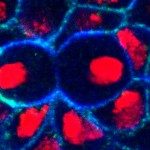Lien vers Pubmed [PMID] – 25843034
Curr. Biol. 2015 Apr;25(8):1104-10
During development, cell-fate diversity can result from the unequal segregation of fate determinants at mitosis [1]. Polarization of the mother cell is essential for asymmetric cell division (ACD). It often involves the formation of a cortical domain containing the PAR complex proteins Par3, Par6, and atypical protein kinase C (aPKC) [1-5]. In the fly notum, sensory organ precursor cells (SOPs) divide asymmetrically within the plane of the epithelium and along the body axis to generate two distinct cells [6-12]. Fate asymmetry depends on the asymmetric localization of the PAR complex. In the absence of planar cell polarity (PCP), SOPs divide with a random planar orientation but still asymmetrically, showing that PCP is dispensable for PAR asymmetry at mitosis [6, 13-15]. To study when and how the PAR complex localizes asymmetrically, we have used a quantitative imaging approach to measure the planar polarization of the proteins Bazooka (Baz, fly Par3), Par6, and aPKC in living pupae. By using imaging of functional GFP-tagged proteins with image processing and computational modeling, we find that Baz, Par6, and aPKC become planar polarized prior to mitosis in a manner independent of the AuroraA kinase and that PCP is required for the planar polarization of Baz, Par6, and aPKC during interphase. This indicates that a “mitosis rescue” mechanism establishes asymmetry at mitosis in PCP mutants. This study therefore identifies PCP as the initial symmetry-breaking signal for the planar polarization of PAR proteins in asymmetrically dividing SOPs.

